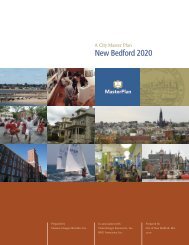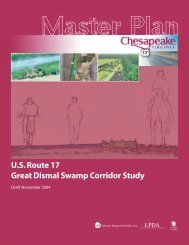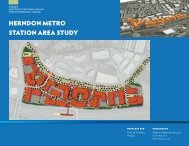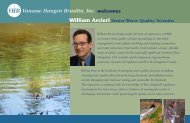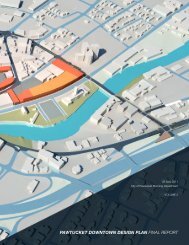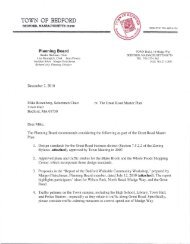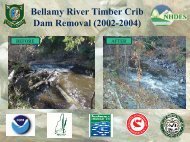Final Report - VHB.com
Final Report - VHB.com
Final Report - VHB.com
Create successful ePaper yourself
Turn your PDF publications into a flip-book with our unique Google optimized e-Paper software.
On behalf of the board of the NorthWest Brunswick Neighborhood Association, I am writing to provide some of our<br />
<strong>com</strong>ments and concerns which we hope will be included in the final <strong>VHB</strong> report. We are naturally concerned with<br />
the aspects of the report’s re<strong>com</strong>mendations that directly impact our neighborhood. Of specific concern is the idea of<br />
widening Mill Street.<br />
The historic NorthWest neighborhood is bordered by Pleasant, Mill and Maine Streets. This area is one of the most<br />
historically significant parts of Brunswick. It includes 2 of the 3 Brunswick homes designed by famed architect John<br />
Calvin Stevens. There are several, well-preserved examples of the original apartment buildings that housed mill<br />
workers in the late 1800s – (the rest were destroyed when the Rt. 1 overpass was constructed). It is home to the<br />
recently restored John Roebling Swinging Bridge, as well as Davis Park – the only accessible in-town green space<br />
besides the mall that is not dedicated to athletic use.<br />
The character of the neighborhood is shaped with an eclectic <strong>com</strong>munity of families, students, retirees, artists, and<br />
professionals from a wide range of economic and cultural backgrounds all of whom are interested in the positive<br />
development and revitalization of their neighborhood. The homes that line our streets, many of which are being<br />
lovingly restored, are a direct link to the original development of Brunswick’s downtown. This <strong>com</strong>bination of<br />
active, friendly, and diverse neighbors, historic architecture, and the walkable proximity to the economic and<br />
cultural vibrancy of Topsham, Maine Street Brunswick, and Bowdoin College, provides a rich quality of life and<br />
makes the Northwest Brunswick Neighborhood an ideal location in which to live.<br />
While you have said repeatedly that the report is not a re<strong>com</strong>mendation to do anything without the <strong>com</strong>munity’s<br />
blessing, it’s not hard to see how some people are viewing it precisely as a blueprint or foregone conclusion for the<br />
future “necessary” or “inevitable” development of Brunswick.<br />
We believe that the report gives vision to several projects which could be very good for Brunswick’s future. We<br />
are confident that many of the Traffic Demand Management strategies that came to the forefront during the Study, if<br />
implemented, will mitigate any need for or interest in expanding Mill. We support:<br />
- New signage on 295 that appropriately routes traffic to the Coastal Connector<br />
- Expanding the Coastal Connector to a consistent width and grade separating the intersection at Rt. 201<br />
- Better management of Rt. 1 southbound traffic as it passes through Brunswick, including the MDOT<br />
study of the intersection of the Rt. 1 off ramp, allowing a left turn onto Maine St.<br />
- Managing Pleasant Street traffic – including the improvement of the intersection at Pleasant, Mill and<br />
Stanwood Streets<br />
- Creating direct access to the base for rail and cars if further research shows it’s needed and costeffective.<br />
There were a lot of good ideas in the report, but we’d like to say in no uncertain terms that the expansion of Mill<br />
Street would unquestionably threaten the quality of life in this increasingly vital neighborhood, and would<br />
irreversibly sever the downtown from our waterfront. The bank of the Androscoggin River in this neighborhood<br />
offers Brunswick’s only possibility for multi-use, in-town waterfront development. With ongoing upstream<br />
improvements in water quality, wildlife restoration and protection, the river that was the sad inspiration for Senator<br />
Muskie’s Clean Water Act, can be a proud example of the potential for waterfront revival. To widen Mill Street,<br />
thereby increasing traffic, pollution and noise. It would be a travesty if such a precious resource for the whole town<br />
was sacrificed to a four lane highway built to ac<strong>com</strong>modate those whose goal is to leave Brunswick and get<br />
somewhere else as fast as possible.<br />
During the Transportation Study process, you were publicly presented with a petition with 100 signatures<br />
requesting that the feasibility of decking-over Mill Street be considered. No formal response to that petition has been<br />
received. Given that those 100 signatures were easily collected online in a short time frame, we know that thousands<br />
of signatures can be collected with a minimum of effort. An intelligent approach to the long term goal of decking<br />
over Mill Street is a concept that could change the future of Brunswick and the region and the perception of Maine<br />
overall. It deserves to be incorporated into the considerations of the current Study and both short and long term<br />
plans for this area.<br />
It seems that the State now owns, or will soon own, property parcels along much or all of Mill Street. This property<br />
should be protected and landscaped to provide sound and visual barriers between the neighborhood and Mill Street.<br />
The homes on Sage Hill, the end of Cumberland and all along Oak Street are particularly vulnerable.<br />
29



